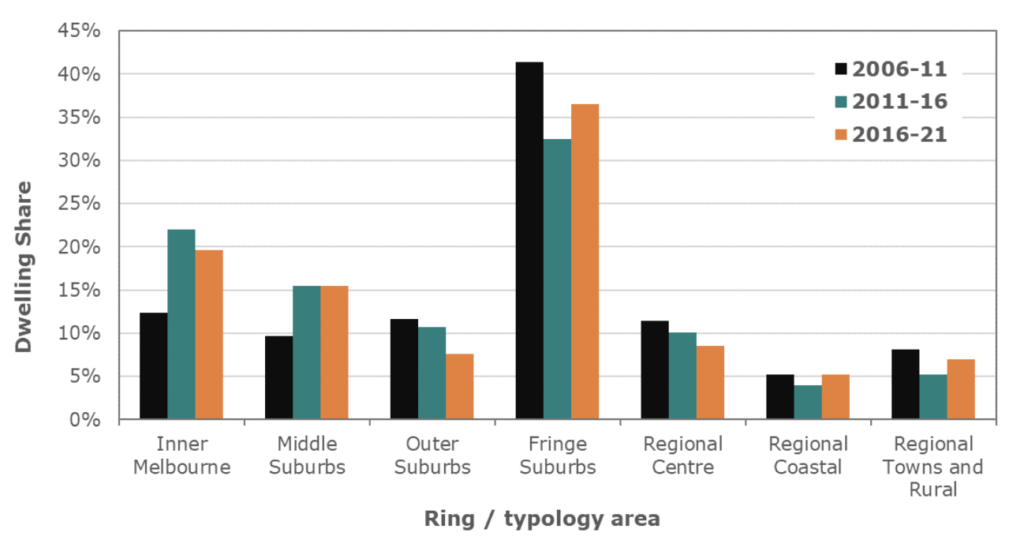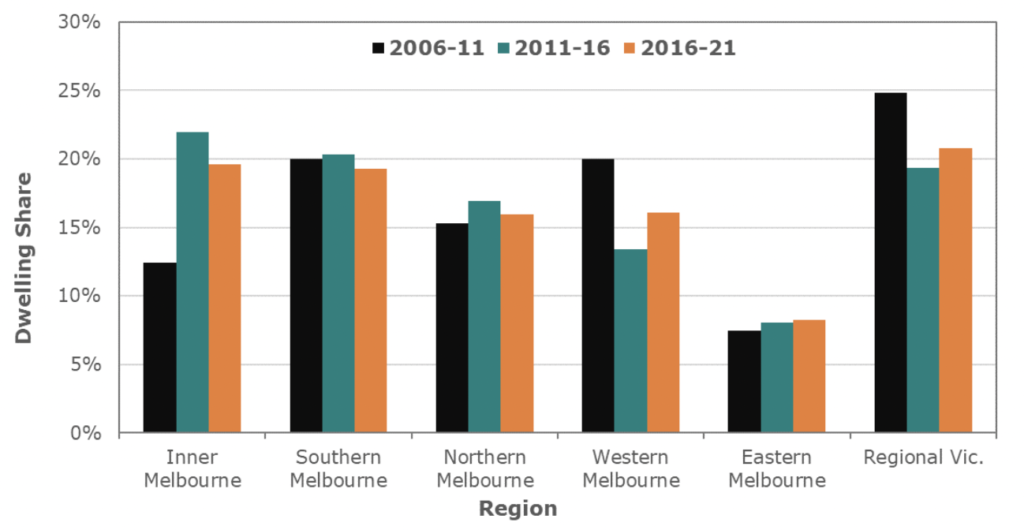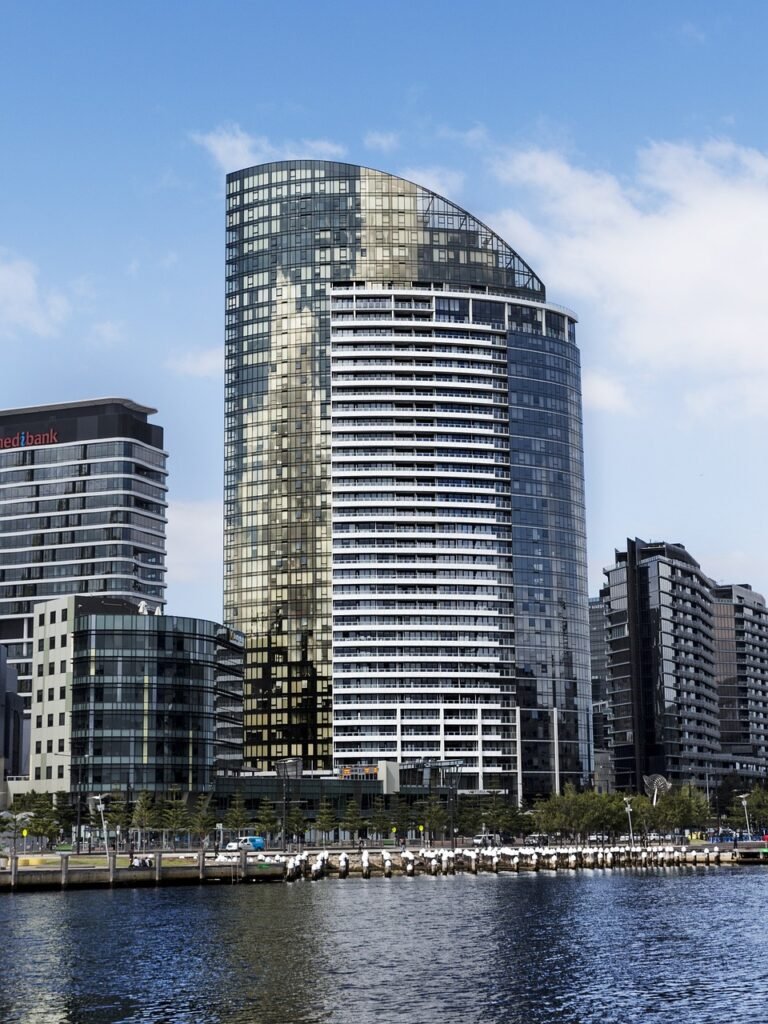Where has residential development in Melbourne occurred?
The beautiful wonderful world of rings and sectors.
Much has been spoken about the changes in development patterns across Australia due to the COVID-19 pandemic. In this article, we analyse dwelling growth in Victoria and Melbourne to discover how development patterns have changed over the last three Census periods.
How did we do it?
We have allocated all ABS SA2 geographies in Melbourne and Regional Victoria in 2021 to a series of categories:
- In Melbourne by sector (inner, north, west, etc.) and ring (inner, outer, etc.)
- In regional Victoria by size of settlements, areas along the coast, and other remaining areas.
SA2s were allocated for 2016 and 2011 and ABS State Suburbs in 2006. Where SA2s or State Suburbs did not conform to 2021 geography over time, areas were split to ensure comparability.
What do the results show?
The results indicate that development has been increasing across Victoria over the last 15 years, with significantly more development occurring in the 2016 to 2021 period.
This translated through to all regions, with the greatest amount of development in the most recent intercensal period. This was not true for all ring / typology areas, with the outer suburbs of Melbourne slowing considerably between 2016 and 2021 compared to 2011 to 2016.
Regional Centres were also relatively stable in number when comparing the three periods. The drop in the outer suburbs of Melbourne reflects dwindling broadhectare supplies and the fact that the rise of medium and high-density redevelopment is not as prominent in these areas.
See table below.
Dwelling additions by Victorian region, 2006 - 2011

Source: ABS, Census of Population and Housing
While net dwelling growth has increased, the share of dwelling additions across Victoria has changed considerably, with certain regions increasing their shares and others falling over time. For much of Melbourne’s history, the eastern and southern suburbs have played a major role in housing Melbourne’s growth.
However, for the last couple of decades, there has been an east to west flow of persons and a proportionately higher share of overseas migration to the west and north. This has been directly associated with greater broadhectare development potential on the western and northern fringe, with more affordable housing options, as well as better proximity to central Melbourne compared to areas in the south-eastern growth corridor.
During the 2006-11 period, the share of growth in the western region was at its zenith, with considerable development fronts in Wyndham, Melton and Brimbank LGAs. While the share fell during the 2011-16 period, the share is back up with more development in Wyndham and Melton. By contrast, Inner Melbourne’s share rose during the five years to 2016, before falling slightly in the five years to 2021. See figure below.
Undoubtedly, uncertainty associated with the closure of the international boundaries would have dampened dwelling growth in the period leading up to August 2021, with such a large share of Inner Melbourne catering for persons from overseas (both tertiary students and other visa holders).
Share of dwelling additions by Victorian region, 2006-21

Source: ABS, Census of Population and Housing
Other regions have maintained much more stable shares. Although Eastern Melbourne has a relatively low share of total residential development, relative to its population, the share has been creeping up over time, with more development occurring in major centres such as Box Hill, Glen Waverley, Doncaster Hill, Mitcham and Ringwood. The region also continues to see solid rates of small-scale unit and townhouse development, especially in areas with larger lots.
Southern and Northern Melbourne have also maintained a relatively stable share, with a minor fall in both regions in the latest inter-censal period. The regions of Southern and Northern Melbourne are able to cater for a range of markets, with more high-density housing options available in the established areas and standard broadhectare options on the fringe.
Regional Victoria experienced a minor increase in share of development to 2021 compared to the previous five years, but the share is still much lower than its 25% share from 2006 to 2011. The changing share reflects different demand across regional areas. The share of development has been falling in regional centres, despite continued strong numbers, with more development in coastal areas over the 2016-2021 period and more in regional towns and rural areas.
A closer analysis of these areas indicates higher rates of dwelling growth in all regions outside of Melbourne, although many of these gains are associated with employment growth in and around Melbourne and major regional centres such as Geelong, Ballarat and Bendigo. See Chart below.
Share of dwelling additions by Melbourne Ring / Regional Typology Area, 2006-21

Source: ABS, Census of Population and Housing
As discussed in previous posts, the amount of development in fringe areas has been on the rise across Australia in the last few years and this is true of Melbourne too. This comes after a longer-term slowdown in fringe areas over the previous two decades, with a much higher share in established areas, notably close to the CBD. The biggest increases on the fringe were in the western region and areas of Melbourne’s north-west, especially in the Hume LGA. This increase can be contrasted against a falling share in inner areas over the same period.
While the share of development has been falling in outer areas, middle suburban areas have picked up the slack. Large scale apartment development has been occurring in places such as Preston, Carnegie, Oakleigh, Heidelberg, Cheltenham, Bentleigh, as well as the aforementioned Box Hill, Glen Waverley, Doncaster Hill and Mitcham. This has allowed the middle suburbs to hold their share, while other established parts of Melbourne have fallen in share between 2016 and 2021.
Where to from here?
Inner Melbourne is again set to increase share with the re-opening of the international borders and some level of post-COVID-19 normality returning. Middle suburbs are likely to maintain share in the short-term, but many of these centres may struggle to maintain high rates of development in the longer term, as the larger and less complicated sites become developed.
Over time, more development may shift to the outer ring of suburbs, as many of these areas have significant untapped development potential. However, some changes to the planning regime may have to occur to facilitate growth. Some outer suburbs are limited for higher density development, due to existing unit development around centres which has fragmented ownership, without achieving especially large increases in dwelling stock.
Fringe development may slow in response to the new higher interest rate environment, but most regions in Melbourne retain at least 15 years’ worth of residential development. However, some changes may occur within regions as development fronts are exhausted and others commence. In the last couple of years, Melton has emerged as the largest supplier of new residential lots, taking some of the demand away from Wyndham. The balance of development in Melbourne’s south-east may also change with the Pakenham East development front commencing.
The demand for coastal and rural living remains strong and the pandemic has highlighted the desire of many to exit the city. The amount of development in these areas will rely on demand from retirees and continued workplace flexibility, facilitating telecommuting and working from home.
Continue watching this space for our Sydney analysis coming soon!

